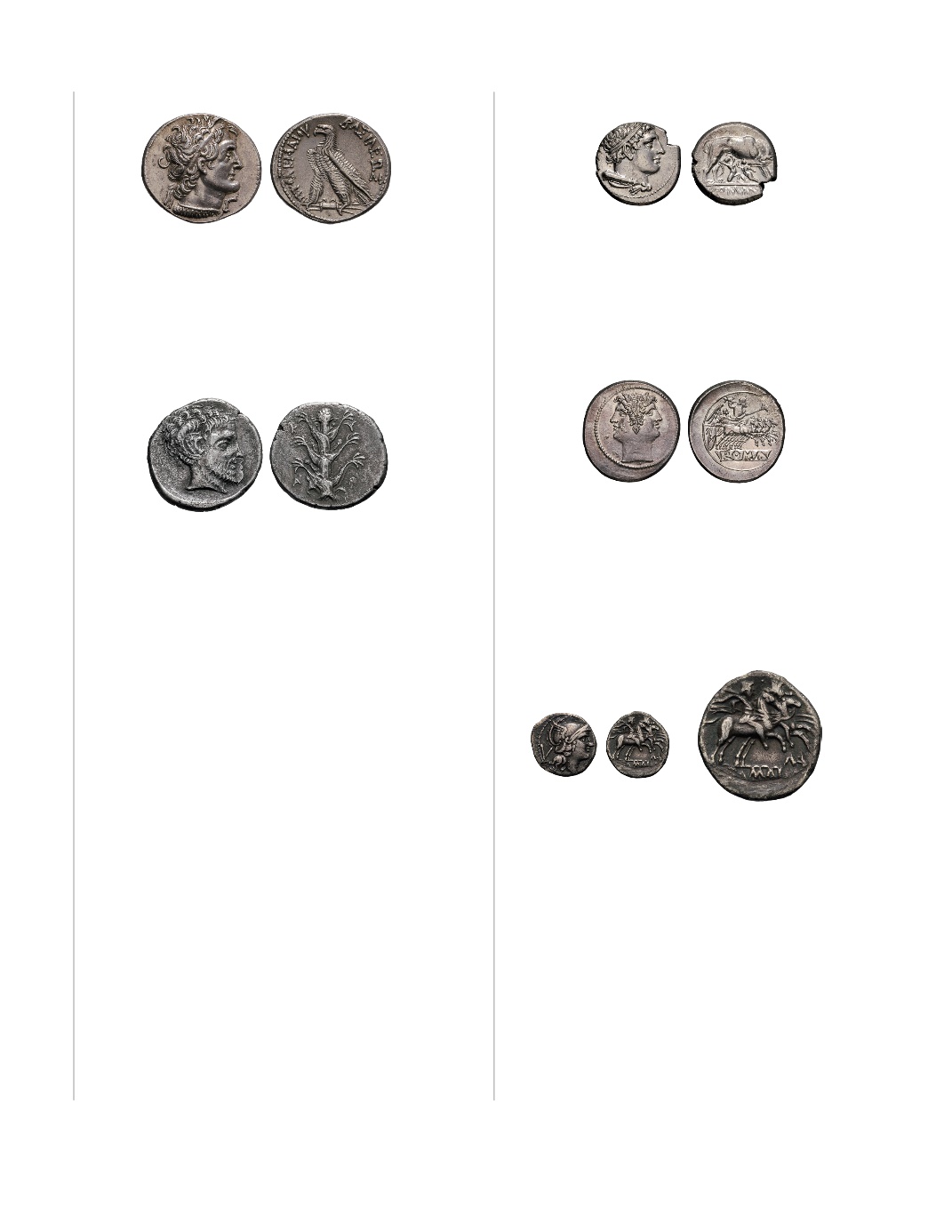

30
108.
Ptolemy VI.
180-145 BC. Tetradrachm, 14.08g
(11h). Alexandria, c. 180-170 BC. Obv: Diademed
bust of Ptolemy I right, wearing aegis knotted round
neck. Rx: ΒΑΣΙΛΕΩΣ - ΠΤΟΛΕΜΑΙΟΥ Eagle with
closed wings standing left on thunderbolt. Svoronos
1489. SNG Copenhagen 262-268. Hazzard C1095.
Struck in high relief. Mint State
$1,600
109.
Cyrenaica, Cyrene.
c. 435-331 BC. Tetradrachm,
12.93g (12h). Obv: Silphium plant with six leaves,
K - V / P - A across field above and below. Rx:
Head of Ammon right with ram’s horn, short curly
hair, and scraggly beard. BMC 73. Porous reverse
surfaces but an impressive piece nonetheless, with
complete and distinct types on both sides. Traces of
overstriking on the reverse do not interfere with the
image of the deity Ammon. EF
$4,500
Ex Frank L. Kovacs. Ex Nilus Coins. Ex G. Hirsch
275, 22 September 2011, lot 4150. Ex Schweizer
Bankverein Zurich 33, September 1993, lot 463. Ex
Christie’s, 22 April 1986, lot 48
.
The Cyrenaica with its Greek cities Cyrene and
Barce was one of the main suppliers of grain to the
ancient Mediterranean world. The silphium trade
was also important, as shown by the use of the sil-
phium plant as a coin type at both cities. Silphium,
a plant that is now probably extinct, was used as
medicine. The other side of the coins of Cyrene and
Barce displayed a head of Zeus in a version spe-
cific to North Africa, with the horns of a ram, thus
equivalent to the Egyptian god Amun. Zeus Ammon,
as the Greeks called him, was introduced to the
Greek pantheon as early as the early fifth century
BC. The Boeotian poet Pindar, who wrote victory
odes for Cyrenian aristocrats, is reported to have
donated a statue of Zeus Ammon to a sanctuary in
his homeland in c. 450 BC. The ram’s horns on a
head of Zeus will doubtless have mystified Pindar’s
unsophisticated fellow-citizens!
Roman Coins
110.
Anonymous, Romano-Campanian.
Didrachm,
6.83g (6h). 269-266 BC. Obv: Head of Hercules
right, hair bound with ribbon, club and lionskin
over shoulder. Rx: She-wolf standing right, suck-
ling twins and turning head back to lick them; in
exergue, ROMAN[O]. Crawford 20/1. Sydenham 6.
RSC 8. Mint State
$1,500
111.
Didrachm/Quadrigatus, 6.21g (12h). 225-214 BC.
Obv: Laureate, janiform head of Dioscuri; border of
dots. Rx: Jupiter standing right raising thunderbolt
and holding scepter, in quadriga driven right by
Victory, whose full figure is visible; below, ROMA
incuse on tablet; line border. Crawford 30/1, pl.
VI.9. RSC 23. Mint State
$1,500
112.
MA, struck by P. Manlius Vulso.
Quinarius, 1.91g
(2h). Sardinia, 210 BC. Obv: Helmeted head of
Roma right, V behind. Rx: Dioscuri riding right;
ROMA below in linear frame. Crawford 64/1.
Sydenham 159. Toned. About VF
$1,500
Purchased from Joel Malter, 4 September 1981
.
Extremely rare; only one example on Coin Archives
with photograph. That coin, the RBW specimen, lot
279 in NAC 61, hammered at 4000 CH +commis-
sion. The obverse of the RBW example was better
centered than that of the present lot, but the sur-
faces were inferior and the MA monogram, the most
important element of the type, was incomplete and a
bit flatly struck
.
Enlargement


















